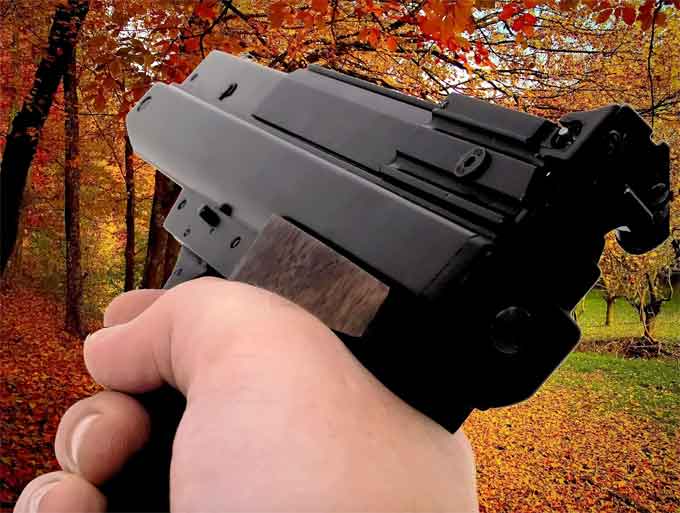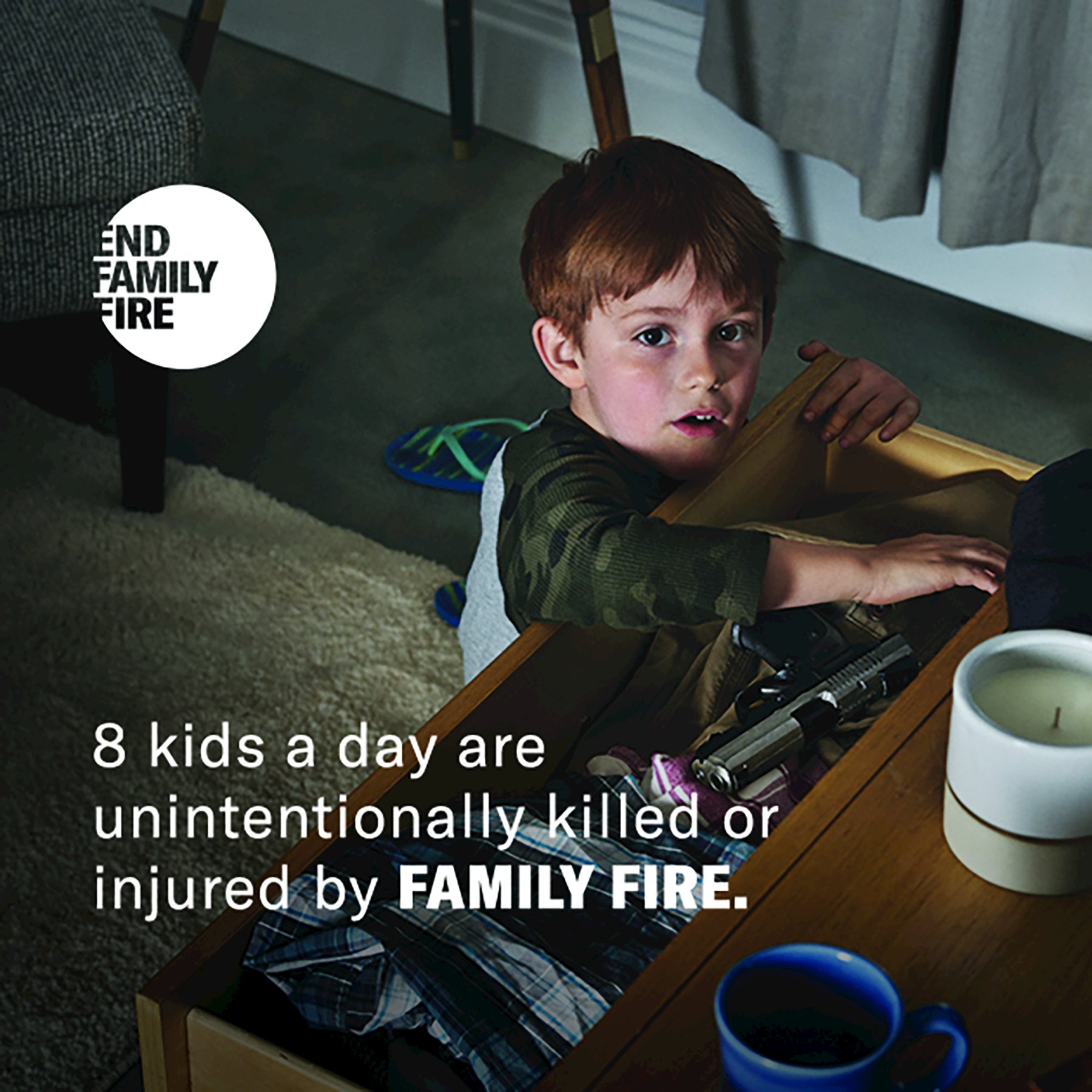
As increasing attention is being paid to gun violence in America, a spotlight is highlighting the impact of the pain and trauma on those struggling to cope in the aftermath of these and other shootings across our nation.
With a number of high-profile mass shooting anniversaries occurring this month, such as the Virginia Tech and Columbine shootings, Brady, Team ENOUGH, the American Association of Suicidology (AAS), and the Disaster Distress Helpline are joining with a number of high profile gun safety and suicide prevention organizations to raise awareness of how communities can support those impacted by gun violence.
The coalition released a new resource which identifies common emotional and physical reactions to the trauma associated with gun violence, and also provides tools to support those experiencing trauma and those seeking to help.
(Learn how access to a gun during a period of personal crisis is often the difference between life and death. Courtesy of Everytown for Gun Safety and YouTube. Posted on Jun 14, 2018.)
“Gun violence leaves physical and psychological scars that can take a lifetime to heal,” explains Kris Brown, President of Brady.
“We need to be there for the millions of survivors, loved ones of victims, and recovery workers on a daily basis, even as we work assiduously to end the scourge of gun violence in this country.”

“As we reflect and honor those who have lost their lives to gun violence, including at Virginia Tech and Columbine, which will have anniversaries this week, we recommit our focus to assist survivors everywhere.”
“We’re grateful to all those who have signed on to support our work with the American Association of Suicidology to reach out to those impacted by gun violence.”
“To all those who have been affected in any way, shape, or form by this epidemic, know that we are with you.”
(Created by Facebook in collaboration with the Lifeline. Courtesy of National Suicide Prevention Lifeline and YouTube.)
Know that you have people who love and care about you. Know that there is help,” added Colleen Creighton, Executive Director of the American Association of Suicidology.
“When someone is shot, whether in a mass shooting or suicide by gun, the ripple effects are devastating.”

“While not everyone affected by mass violence goes on to experience thoughts of suicide or mental health issues, community support for survivors and for their loved ones is critical in the subsequent days, months, and years.”
“Support for those who work in this field every day, including first responders, crisis workers, teachers, and school professionals, also creates a stronger community.”
“Something as simple as reaching out to a loved one to see how they’re doing can do wonders.”
“If you are worried that someone is in distress or feeling suicidal, don’t wait for someone else to take action.”
“Be the person to help save a life.”
(Learn More. Call I-800-273- TALK (8255). Courtesy of National Suicide Prevention Lifeline and YouTube.)
The new resource notes that traumatic events can cause emotional distress, particularly to survivors living or working in impacted areas, the loved ones of victims, and first responders, rescue, and recovery workers, and provides tools to support those experiencing trauma and those seeking to help.
It reminds of the importance of checking in – checking up – and checking often – to support yourself and others in distress, and offers ideas of what to say to someone who may be in distress.
Supporting partners of the initiative include:
- American Association of Suicidology (AAS)
- Brady
- Coalition to Stop Gun Violence (CSGV)
- Disaster Distress Helpline
- Education Fund to Stop Gun Violence (EFSGV)
- Everytown for Gun Safety
- Gays Against Guns
- Grandmothers Against Gun Violence
- Newtown Action Alliance
- One Pulse for America
- States United to Prevent Gun Violence
- Vibrant Emotional Health
- Women Against Gun Violence (WAGV)
(Learn More. Call I-800-273- TALK (8255). Courtesy of National Suicide Prevention Lifeline and YouTube.)
To Learn More about the effect of the presence of guns in suicide attempts and deaths, please see “The Truth About Suicide & Guns,” a 2018 Brady report.
To find out about safe storage of guns in the home, please visit endfamilyfire.org.

AAS outlines a number of additional individual and population-level means safety guidelines in this 2018 policy statement.
Responsible reporting on suicide, including stories of hope and resilience, can prevent more suicides.
Please visit the AAS’ Suicide Reporting Recommendations for more information.
If you or someone you know is contemplating suicide please call the free and confidential National Suicide Prevention Lifeline at 1 800 273 8255 or contact the Crisis Text Line by texting TALK to 741-741.
(There are a million reasons to call the National Suicide Prevention Lifeline. Watch musician Rhett Miller talk about his suicide attempt and why he is glad the Lifeline is here to help. Call I-800-273- TALK (8255). Courtesy of National Suicide Prevention Lifeline and YouTube.)
Suicide: Risk and Protective Factors
Risk Factors for Suicide
A combination of individual, relationship, community, and societal factors contribute to the risk of suicide.
Risk factors are those characteristics associated with suicide—they might not be direct causes.
Risk Factors
- Family history of suicide
- Family history of child maltreatment
- Previous suicide attempt(s)
- History of mental disorders, particularly clinical depression
- History of alcohol and substance abuse
- Feelings of hopelessness
- Impulsive or aggressive tendencies
- Cultural and religious beliefs (e.g., belief that suicide is noble resolution of a personal dilemma)
- Local epidemics of suicide
- Isolation, a feeling of being cut off from other people
- Barriers to accessing mental health treatment
- Loss (relational, social, work, or financial)
- Physical illness
- Easy access to lethal methods
- Unwillingness to seek help because of the stigma attached to mental health and substance abuse disorders or to suicidal thoughts
(For over 25 years, Brady has been fighting to unite all Americans against gun violence. This animated film tells the inspiring story of the movement started by Jim Brady and his wife, Sarah, after he was shot during the assassination attempt on President Reagan. Courtesy of Brady and YouTube. Posted on Feb 26, 2019.)
Protective Factors for Suicide
Protective factors buffer individuals from suicidal thoughts and behavior.
To date, protective factors have not been studied as extensively or rigorously as risk factors.
Identifying and understanding protective factors are, however, equally as important as researching risk factors.
Protective Factors
- Effective clinical care for mental, physical, and substance abuse disorders
- Easy access to a variety of clinical interventions and support for help seeking
- Family and community support (connectedness)
- Support from ongoing medical and mental health care relationships
- Skills in problem solving, conflict resolution, and nonviolent ways of handling disputes
- Cultural and religious beliefs that discourage suicide and support instincts for self-preservation
Need Help? Know Someone Who Does?
Contact the National Suicide Prevention Lifeline
-
Call 1-800-273-TALK (1-800-273-8255)
-
Use the online Lifeline Crisis Chat.

















